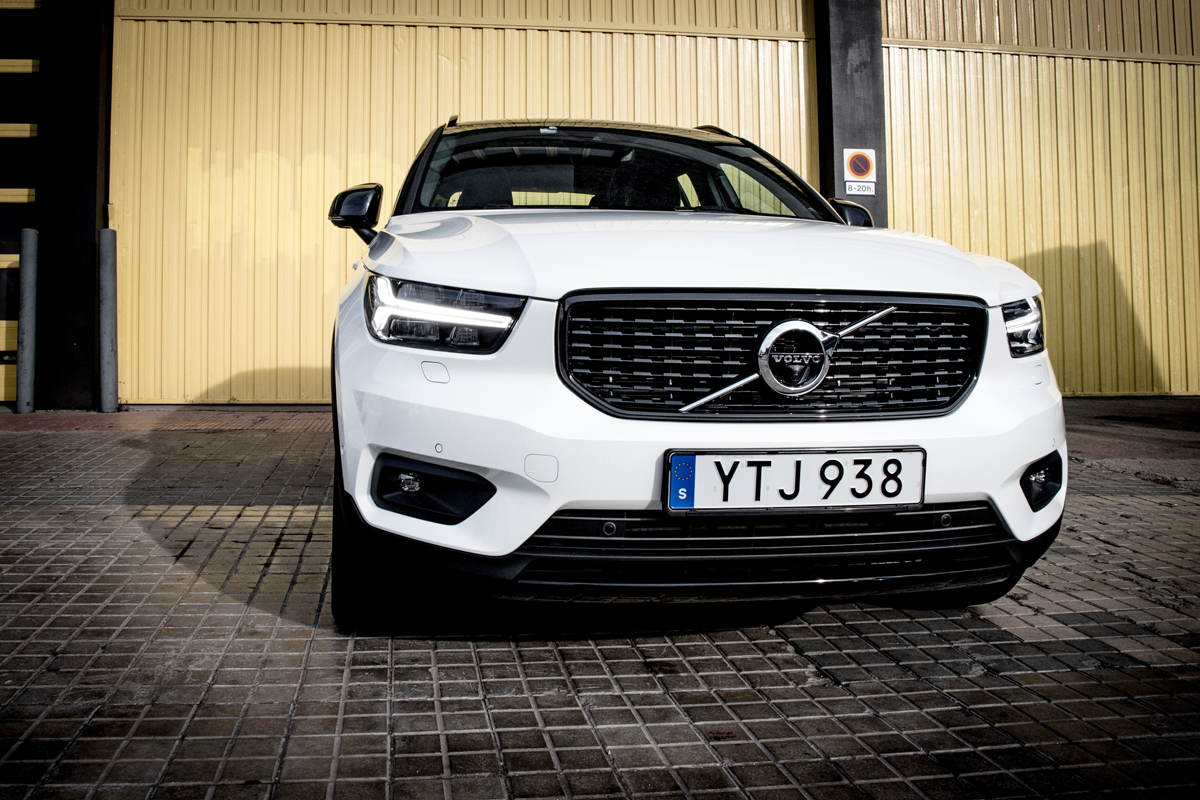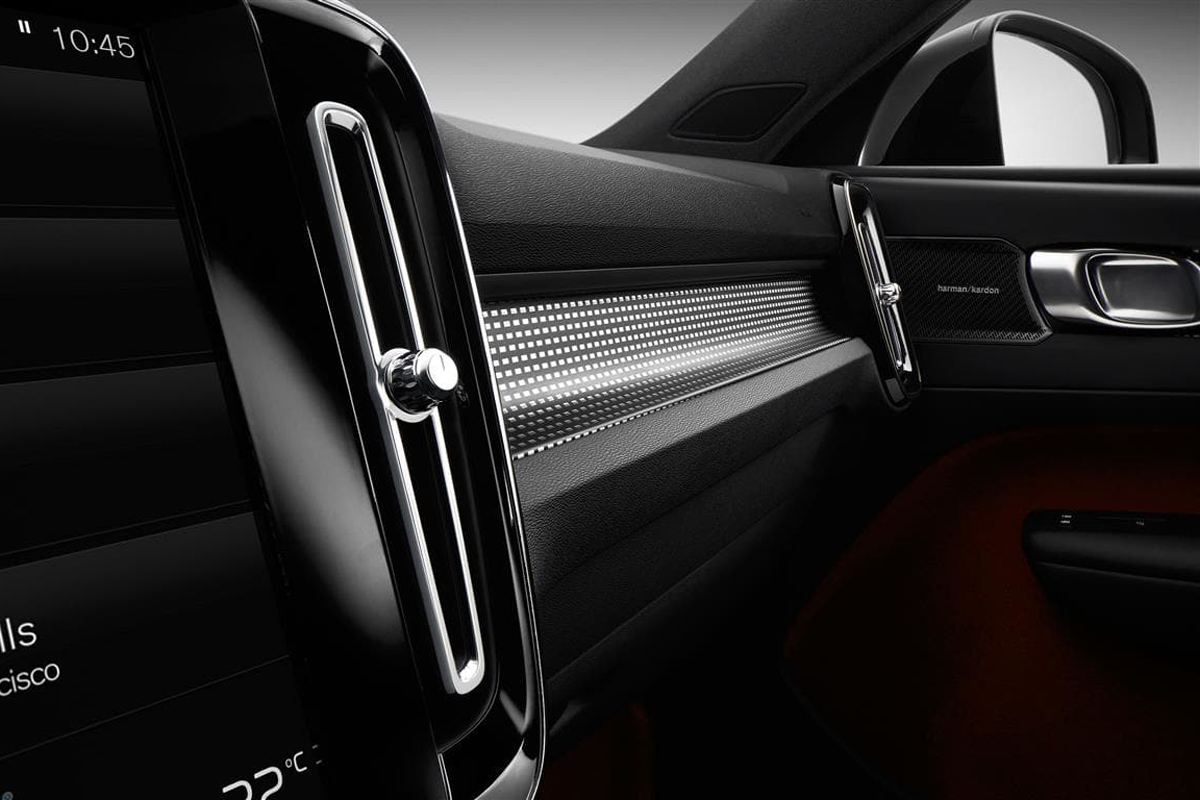Test Drive: 2018 Volvo XC40
With plenty of clever utilities, this slick crossover is deceptively simple

by Michael Frank
This is a deceptively simple looking crossover. From the side the mid-size XC40 looks substantial, chunky, and only the Thor’s Hammer headlamps (that form an arrow-like beam) and hockey-stick tail-lamps tick Volvo signature boxes. But look closer and Volvo’s split the junction of front fender, hood, roof, and front door in an unconventional pattern. The hood doesn’t quite square up with the shoulder line of the door or nest directly into the door pillar. That’s on purpose. It adds a little flair of complexity without the bent-metal side creasing that (maybe) has reached its peak at long last.

Similarly, Volvo designer Robin Page, who we interviewed at the LA Auto Show about the car, pointed to the fact that designers knew about the two-tone roof option from the start, and that allowed them to curve the roof to catch light, and give the illusion of greater height, while also design the top-line of the tail-lamps to perfectly intersect with the junction of roof paint and body paint. This has the visual effect of making the entire roof look longer, and thus, the car look a little slicker, but again, without creasing metal or making the XC40’s profile too busy.

All this focus on design might seem like overkill, but Page and others at Volvo know exactly what’s bringing their brand back: attention to detail. While other carmakers will boast about their designs, Volvo knows its niche, in a decidedly Swedish space, is to do things as simply and understatedly as possible. Yes, they add some level of cheek where they can—thought it’s at a high level, and with an avowed effort to avoid aggression. So while the XC40’s grille is actually larger than that of the much larger, seven-passenger XC90’s, the “face” of the car isn’t at all snarling. Page says the spirit-animal inspiration for the car is the English bulldog, which is a face you can’t help but see in the XC40 once you know that.

As for what else Volvo has achieved here, that’s more up to needs versus desires. First, at a base of $33,200 (front-wheel drive) and $35,200 for the AWD version, the XC40 is priced somewhere between the BMW X1 and Audi Q3, and it compares to both of those compact crossovers on size, too. The Volvo’s not as tiny as the cute-ute, tall car category, but it’s also not a genuine mid-size crossover, like the larger XC60. But it is smartly designed around everyday toils, with an extra-clever parcel shelf that is hinged in tandem with the rear hatch lid, but can also be removed and stows neatly below the hatch floor, so you can get it out of your way without having to find a place in your garage for it to live. That hatch floor also accordions to make room for grocery bags, and when it’s folded, reveals hooks that form from the hinges. Volvo split the rear seats 40/60, but also made a pass-through standard, which is handy not just for skiers and anglers, but for anyone who makes runs to the hardware store or digs antiquing.
Utility continues up front, too, where extra deep and wide on-door storage will fit up to a 15-inch laptop, and there’s even a drawer beneath the driver’s seat, if you want to stow small items out of plain sight. And there’s an removable tiny trash bin that lives in the center console, too. (It’s so clever, we’re thinking there’s probably a massive aftermarket for in-car trash cans that nest in existing armrests.)

We’re also impressed by everything Volvo has made standard on the car. As you’d expect, that includes plenty of safety features, ranging from pedestrian-, cyclist- and large animal-detection to lane keeping (a system that will steer the car back into its own lane if you’ve veered into the oncoming lane), road-sign reading, automatic braking (if you’ve been in an accident and have yet to stop the car) and another system that takes evasive action to prevent the car from drifting off the road.

Beyond safety, Volvo includes standard features that other European brands charge extra for, like wireless phone charging, heated wiper blades, a standard, very large, nine-inch TFT central digital control panel and 12.3-inch instrument panel (that’s basically a display as well), and Android Auto/Apple CarPlay. The seats are brilliant, too and come with standard lumbar adjustment for the driver and front passenger. And even though this ute is small-ish, it’s Swedish, so tall passengers fit comfortably in both rows (though three-across room in the aft row would be tight for adults).

Dynamically, while testing the XC40 in and around Barcelona, we found the car a lot more engaging than the norm for the breed. Sadly, that blanket demerit too frequently even includes some of Volvo’s German competition these days, too, so it’s refreshing that Volvo’s managed to make the XC40 enjoyable to drive with verve. Impromptu traffic circle skid-padding proved the small Volvo perfectly stable at tire-smoking antics, and predictable for evasive maneuvers when called upon. If that’s not your thing, just drive the XC40 with reserve, and you’ll still find its agility rewarding, especially when you’re trying to park or change lanes in traffic. And for buyers who might demand something yet more sporty, Volvo will eventually offer an option with a stiffer suspension, though that might ruin the just-right equilibrium we encountered during our testing. Regardless, if you get the T5 edition, your XC40 will be quick; we got used to the 2.0-liter turbocharged engine’s ever-ready hit of torque (258 lb ft), and the fact that you’re rarely revving the T5 hard to achieve pace. The brakes in our pre-production car were a hair touchy, but that’s about the only dig we’d offer.

One revolutionary aspect of the XC40 worth mentioning is that when the car goes on sale this coming March, Volvo is debuting something called Care by Volvo. The idea: You give Volvo between $600-$700 a month (depending on whether you choose a base car or the higher level, R-Design trim) and you get an XC40 to drive. The down payment versus the many grand you have to pay for a lease, is a scant $500 and insurance is included. Unlike a lease, the 15,000-mile annual allowance is very generous, and after just a year, you can re-up to drive a totally new car. Volvo says if you pencil out the cost of ownership or leasing, you may find the math makes more sense to do the latter, but their play is that a lot of customers don’t want to bargain with a dealer and don’t want the other hassles of ownership, such as maintenance, which is baked into Care by Volvo as well. Their thinking, and perhaps yours too, is that you’re already paying over $7k a year to drive an older car now—when you include payments, taxes, insurance, and maintenance—so lots of buyers might prefer driving an always-new Volvo instead. And if it’s the XC40, it’s a pretty great option, too.
Hero image and interior shots courtesy of Volvo, all others by Michael Frank












